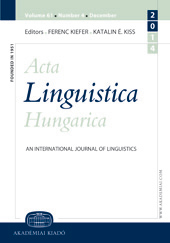On the grammaticalization of the Estonian perfective particles
On the grammaticalization of the Estonian perfective particles
Author(s): Anne TammSubject(s): Morphology, Syntax, Finno-Ugrian studies
Published by: Akadémiai Kiadó
Keywords: grammaticalisation; Estonian; aspectuality; perfectivising function; argument structure;
Summary/Abstract: This article presents two grammaticalization types of separable perfective particles in Estonian. The bounding particle (BP) use of the semantically most bleached Estonian separable verbal particle ära is demonstrated to display a distinct status in the grammaticalization of aspect. The special character of the BP is illustrated by contrasting the BP ära, on the one hand, with the well-established use of the particle with the same form (ära) and, on the other hand, several other perfective particles, which are referred to here as instances of completive particles (CP). The study of differences brings out the following novel facts about the BP. The particle occurs only in context-dependent, agentive sentences that typically describe the achievement of planned or foreseen endpoints of events. The perfective sentences with the BP contain primarily activity verbs; however, verbs in such sentences can belong to all aspectual classes, and the combinations are transparent. The occurrence of an argument that would serve as a “measure” for the event is thereby optional. The evidence that the BP and verb combinations do not allow for the derivation of adjectives (participles) also demonstrates the difference between the principles of combining a verb and a BP as opposed to a CP.
Journal: Acta Linguistica Hungarica (Since 2017 Acta Linguistica Academica)
- Issue Year: 51/2004
- Issue No: 1-2
- Page Range: 143-169
- Page Count: 27
- Language: English

